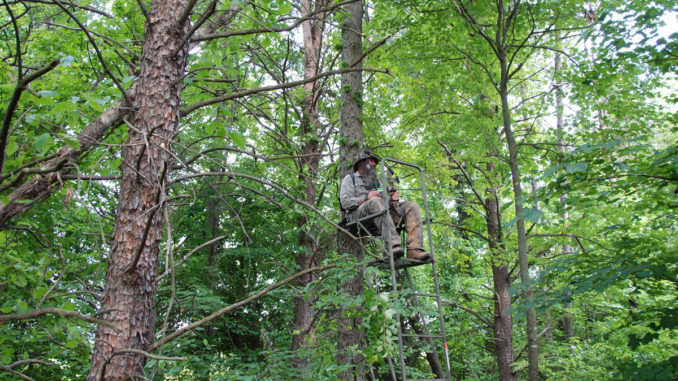
Look at your hunting situation and pick the deer stand that gives you the best chance of tagging that buck.
The tree-stand industry is a multimillion-dollar business, in part because there’s something for everyone and ever style of hunting.
From big, pre-molded manufactured blinds that resemble really nothing in particular to small, portable strap-on stands, climbers, ladder stands for one or two people. tripods, quad-pods and ground blinds that look like tree stumps.
But using the right stand for the right situation is where hunters can tilt the odds in their favor.
Deer hunters in general and bowhunters in particular are very picky about what type of stand they prefer, but by allowing the situation to dictate what type of stand to use, you maximize your opportunities to harvest that buck.
Around food plots, many hunters prefer ladder stands and box blinds — manufactured or homemade — which stay in the same location for years and become so much a part of the landscape that deer don’t notice them. When hunters take care setting them up, they can last for decades.
The stability and ability to hide the ladder in foliage makes this a preference over big box blinds for many, but others prefer the comfort of box blinds — both work best around food plots. If a suitable tree isn’t available, a tripod would be a good choice. Regardless, set it up and leave it alone. In many cases, it could be the second or third year before it really pays off.
When hunting close cover, acorn ridges or other natural food sources, most archers prefer the strap-on style of stands. Their low profile and ease of setting up make them a great choice. The platforms and front-facing stance makes them ideal for bowhunters, but gun hunters shouldn’t leave them out of their arsenal either. It would be prudent to add that the use of climbing sticks or ladders are far safer and easier to use than screw-in steps. One thing to keep in mind when setting up a strap-on stand is to keep cover around you, especially as a back drop to break up your outline. Also, trees with a lot of limbs are not a problem for the strap-on style. The limbs help hide you and break up your outline.
Many hunters who consider themselves trophy hunters admit readily that if they were forced to use one stand and one stand only, it would be a climber. Several factors should be kept in mind when selecting one. Light weight is important when carrying it a long way. Second, pick one that is quiet to set up; nothing will blow a hunt quicker than rattling metal when setting up in the tree; this is where the coated cables or straps are an excellent choice. Third is comfort. Few things make for a long hunt than being uncomfortable in your stand. When you are uncomfortable in your stand, unnecessary movement, fidgeting, shuffling will prevent the hunter from paying attention and possibly alert deer to your presence. A good sling seat is difficult to beat for comfort.
The great asset to the climber is the ability to slip in close to an unsuspecting buck, have a great hunt and slip out — leaving no trace and not letting the deer know you were ever there.
Regardless of the type of tree stand you choose, always, wear a safety harness. Much has been written and said about this important piece of equipment, but it can’t be stated strongly enough. You owe it to yourself and family to return home safe.
More and more hunters are using what is known as ‘pop-up’ ground blinds. Whether the hub style or the spring steel, these manufactured blinds are extremely portable, lightweight and excellent choices in the right situation. One of the best places to use these blinds is in the middle of agriculture fields. Some fields are a half-mile across, and shooting across them is iffy at best. This is where a good ground blind, set up in the middle of a field will often pay off.
Planted pine plantations are another spot for a ground blind. These plantations often are thick, and climbing or elevating at all isn’t practical and doesn’t provide the desired effect. But setting up a ground blind can often put deer to within feet of your set-up. These blinds also allow for hunters to conceal more movement and odor.
Some hunters prefer to use homemade ground blinds, and the variation is only limited to the hunters imagination. Constructing a blind of natural vegetation in late winter for the following season is a great start. This allows for the deer to get accustomed to its presence, and its natural appearance will not alarm them.
By allowing the situation to dictate your stand choice, you are really putting the odds in your favor come October and November. Don’t use a “one-size-fits-all” approach. Look at your set-up and pick the stand that fits the situation, and you will be more successful.







Be the first to comment